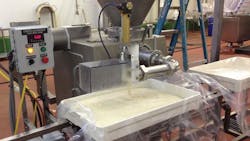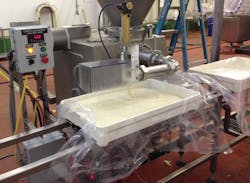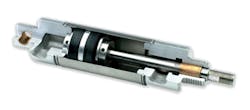The cheese in colorful packages at supermarkets usually starts out in a completely different form. In one such case, machines pour a heated, liquefied cheese product into large fiberglass trays, where the product cools and solidifies. It is then cut into small pieces for subsequent packaging.
Using a process known as index and fill, the machines continuously weigh the cheese as it flows into trays. When it reaches a pre-set weight, a tray is moved to the next station. However, manually moving trays weighing up to 100 lb. along a conveyor line is hard work. To help automate the process, a major food manufacturer turned to Charter Engineering, Portland, Ore., a specialist in the design and construction of food-processing machinery. The goal was to streamline an operation that moves trays through the fill-and-weigh operations, then to the unloading station.
Charter’s engineers considered several options when designing the motion system. Competitive quotes showed electromechanical-based systems were more costly than other alternatives. Designs using conveyor belts also were evaluated, but they were considered too difficult to clean. The most efficient and cost-effective option was determined to be a pneumatic forward-push system that continuously moves the trays as they are filled and weighed.
For this particular challenge, Charter Engineering partnered with Clippard as its pneumatic component supplier. According to Jay Rosen, P. E., owner of the Charter Engineering Group, “Clippard components have been used by our company on many products over the years. The stainless-steel cylinders are long-life, offer washdown capability, and are reliable. Their costs are competitive but, more importantly, Clippard’s application engineering staff has always been helpful and supportive on product questions for new and custom applications.”
The fill-and-weigh motion system involves a three-stage process. After a tray reaches half of the required fill, stainless-steel air cylinders push it forward to the next station, where the filling process completes. Cylinders then push the trays forward to the unload position for transport to the cooling area.
The fully automatic forward-push system uses several Clippard products, including two UDR-32 stainless steel cylinders with magnetic pistons, an RPS-S3 magnetic reed switch, and a JFC flow-control valve to control the indexing.
Stainless Cylinders
Charter Engineering’s staff specified Clippard stainless-steel pneumatic cylinders for their rugged, long-life design. The UDR-32 cylinders have a 2-in. bore and were selected from more than 130 different models and 15 standard bores.
The design features polished-ID stainless steel tubes, precision-rolled construction, machined aluminum heads, sintered bronze bushings, and ground, polished, and roller-burnished 303 stainless rods. Nitrile U-cup piston and rod seals ensure low-friction operation and leak-free operation.
The cylinders include an internal piston magnet that’s used to trigger a reed switch and GMR sensor. Accurately sensing the magnetic field when the piston passes beneath the sensor sends a feedback signal to the controller to confirm the position.
Flow Controls
Combination needle and check-valve flow controls typically are used to meter flow from air cylinders, thereby controlling the speed at which the piston strokes—either extending or retracting, depending on their location in the circuit. J-Series flow-control valves
permit free flow in one direction; the needle valve meters flow in the opposite direction.
The flow controls have several built-in features to simplify designs. The inlet port can swivel 360° for optimum port alignment. The valve’s needle cannot be removed from the stem. And super-fine 48-pitch needle threads provide excellent adjustment capability.
The user’s original operation required three or four people to manually push trays through the weighing operations and then to the unloading station. The new pneumatic motion system pushes several hundred trays through the process in one day with only one worker. According to Charter Engineering’s Rosen, similar applications involve other types of containers—including, bags, boxes, and crates—where high fill rates are needed. In such operations, the pneumatics moves containers weighing more than 25 lb. with cycle times of less than 15 seconds.
For more information, call Clippard Instrument Laboratory at (877) 245-6247, or visit www.clippard.com.
About the Author

Leaders relevant to this article:


